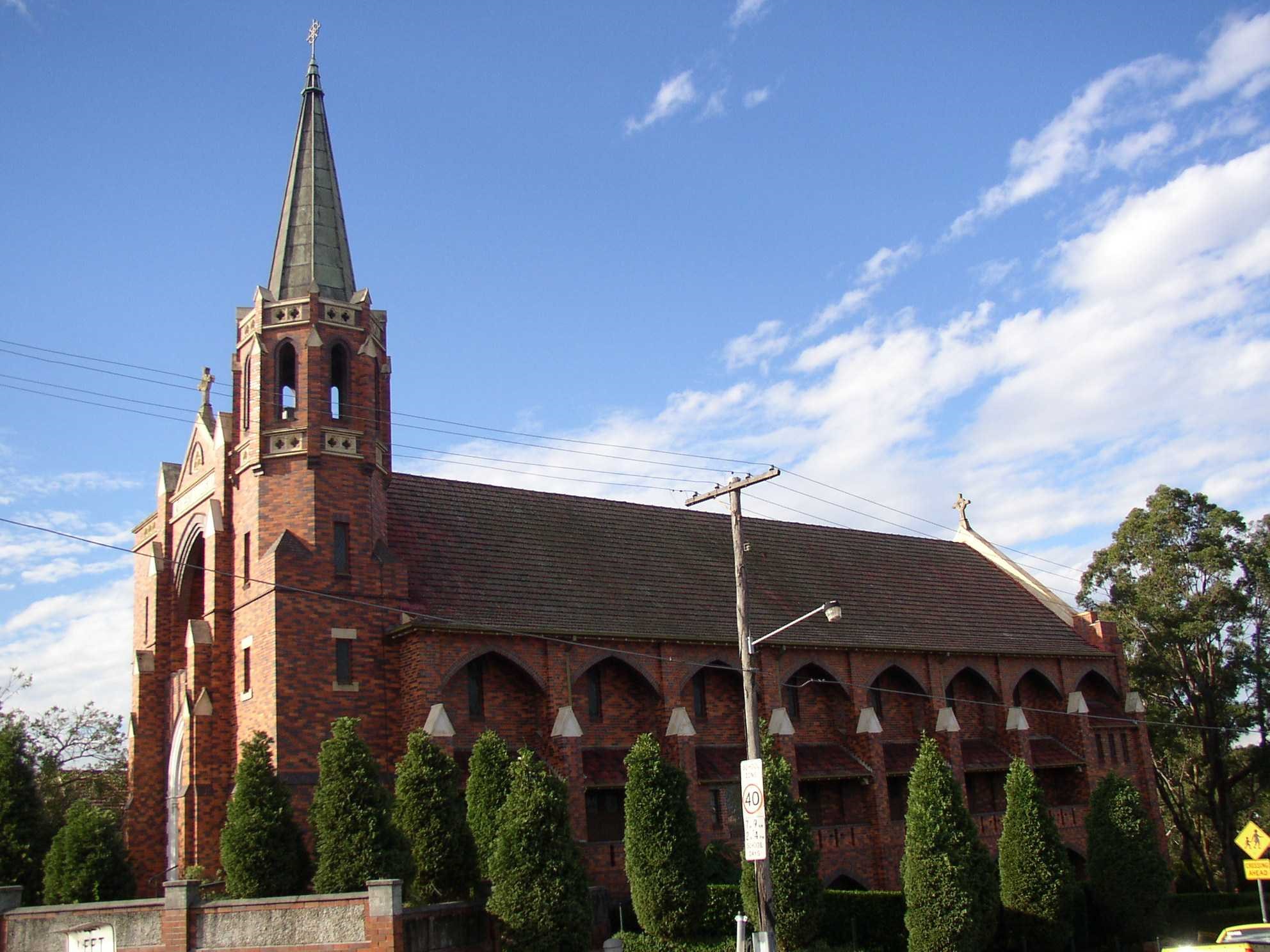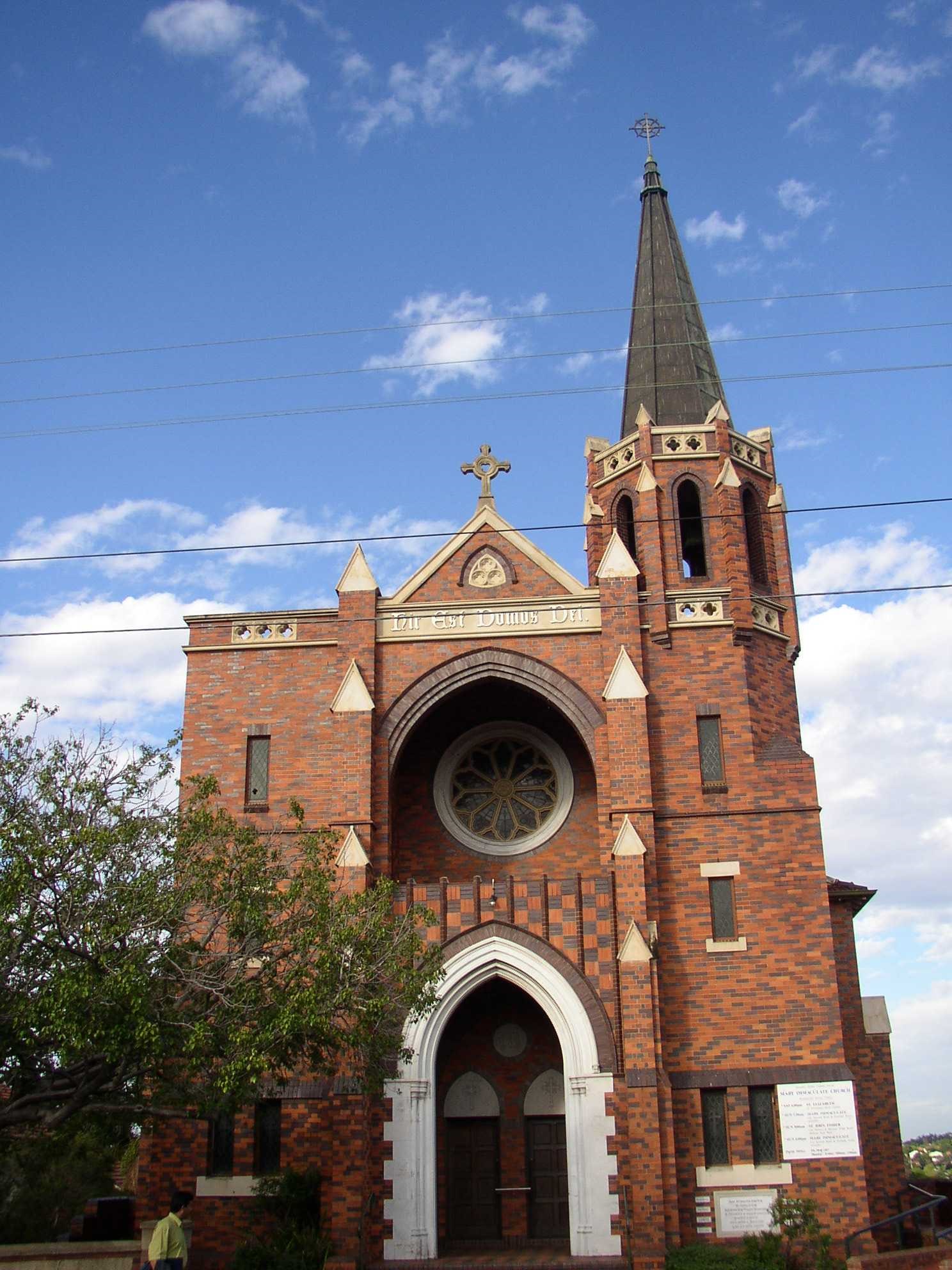Addresses
Type of place
Church
Period
Interwar 1919-1939
Style
Gothic
Addresses
Type of place
Church
Period
Interwar 1919-1939
Style
Gothic
This Catholic Church was opened in 1932 by Archbishop Duhig and was the first of many church properties that he was instrumental in developing around Brisbane. As a large, polychromatic brick Interwar Gothic style church at the intersection of several suburbs, it is significant for its intact architecture and landmark status. The building of this church during the Great Depression demonstrates the determination of the Catholic community of Annerley to raise funds to build a local church and school and their contribution to providing employment for nearly 30 men. The church and adjacent primary school were designed by J. P. Donoghue.
Lot plan
L1_RP149789
Key dates
Local Heritage Place Since —
Date of Citation —
Construction
Roof: Terracotta tile;Walls: Face brick
People/associations
John Patrick (Jack) Donoghue (Architect)Criterion for listing
(A) Historical; (D) Representative; (E) Aesthetic; (G) Social; (H) Historical associationInteractive mapping
Lot plan
L1_RP149789
Key dates
Local Heritage Place Since —
Date of Citation —
Construction
Roof: Terracotta tile;Walls: Face brick
People/associations
John Patrick (Jack) Donoghue (Architect)Criterion for listing
(A) Historical; (D) Representative; (E) Aesthetic; (G) Social; (H) Historical associationInteractive mapping
History
The present Mary Immaculate Catholic Church was opened by Archbishop Duhig on 8 May 1932. Described in the Architecture and Building Journal as "another milestone in the progress of our ecclesiastical church designs", it replaced the earlier combined Church and School which had served the needs of parishioners since its opening in 1914. J.P. Donoghue, the architect responsible for the church, also designed Holy Spirit Catholic Church, New Farm (1930).
Although much of the land in Annerley had been surveyed and mapped prior to separation in 1859 and several large holdings established, it was not until the 1890s that the first residential estates in the immediate vicinity of the site on which Mary Immaculate now stands were developed. Over the next thirty years residential development of the area continued, accompanied by the provision of urban amenities, public transport, and other community facilities. The increasing local population established places of worship reflecting the importance of religious practices in their lives.
Among the earliest of the churches to be erected in the locality now known as Annerley were the Presbyterian Church in the Thompson Estate and the Annerley Methodist Church in Ipswich Road. It was not until 1912 that land was purchased to provide for the spiritual and educational needs of the growing number of Catholics in the vicinity. Prior to the opening of Mary Immaculate at Annerley, Catholic residents of the community had attended St Joseph's Catholic Church at Kangaroo Point, or taken the tram to St Stephen's Cathedral in the city. The Catholic community in Annerley was part of the parish of Coorparoo under the care of Father O'Leary until Ipswich Road became a separate parish in 1916.
Moves to establish a Catholic Church in the area were led by Walter Freney, W.J. de Lange and Lionel Mellish who approached Archbishop Duhig on behalf of the increasingly large Catholic community in the area, stressing "the long distance to St Joseph's Church, Kangaroo Point, over which they had to walk every Sunday morning to attend Mass." Duhig bought the property in October 1912 for £700. It was his first purchase of land after being appointed Coadjutor to Archbishop Dunne. That first timber church/school was dedicated 14 June 1914 by Archbishop Duhig, the foundation stone having been laid on 23 September 1913. Constructed at a cost of £2,010, the church was built by E. Dahlke to the plans of G. Trotter, Jr, architect. C.W. Lyon completed the painting of the interior.
In 1916, Father James Gallagher was appointed resident priest of the new parish. On 11 February 1917, the convent adjacent to the church and the presbytery on the other side of Ipswich Road were opened by Archbishops Duhig and Mannix. Both buildings had been purchased the previous year by Duhig. The original timber church/school and convent are no longer on the site.
The first church on the site was primarily built to provide a Catholic school for the Annerley area, and was intended to serve only temporarily as a church. In 1929, Father James Kelly was appointed parish priest with instructions from Archbishop Duhig to build a church. Father Kelly would remain in this position for 41 years. The parish finances at that time were £2,095 in credit. The new church was to be built in memory of Father Gallagher, who served as parish priest until his death in 1924. The present Mary Immaculate church was designed in the French Gothic style and constructed at a cost of approximately £9,400 by Mr Freeman of the Marberete Company, who donated the foundation stone. The foundation stone was laid by Archbishop Duhig on October 11, 1931 in the presence of 27 priests of the archdiocese. The Archbishop returned on 1 May 1932 to dedicate and officially open the church.
That this church was built at the height of the 1930s depression is testimony to the determination of this parish to construct a substantial place of worship. At the time of the church's opening, £5,300 towards the total cost of £10,500 was in hand. A further £560 was collected at the opening ceremony, a significant sum during a period of such severe hardship. Socials and other fundraising functions were held in the parish to help clear the remaining debt on the church. The construction of the church provided work for 30 men representing a conscious effort by the Catholic Church to help alleviate unemployment.
A new £16,000 brick presbytery was built in 1961, under the direction of parish priest, Monsignor James Kelly. This solved the problem of busy traffic separating the priest’s residence from the church. A convent has been erected adjacent to the new presbytery, and a new church hall built facing Ipswich Road. A particularly strong commitment to education has been a benchmark of this parish, with the Sisters of St Joseph playing an important role in the parish school. A new two-storey primary school building, also designed by Jack Donoghue, was completed in 1955. Secondary education commenced for the first time at the school in July 1964 with the opening of a new secondary school classroom block designed by architects Frank L Cullen, Fagg, Hargraves and Mooney. The new school was erected on land adjoining the existing church property purchased by Monsignor Kelly.
In the years since the construction of the present Mary Immaculate Church, the parish has continued to expand and to serve the Catholic community of Annerley, continuing a tradition of worship and education on the site of some eighty years.
Description
This French Gothic style church dominates the south-western corner of the site which it shares with a presbytery, convent, classroom buildings and other associated school facilities. Apart from the church, all buildings on this site have been constructed after 1950.
The church is built in the traditional form with a western front that is located close to the Ipswich Road alignment. The small entrance porch is flanked by a bell tower located on the right hand side of the entrance.
The building is rectilinear in plan form, terminating with a semi-octagonal apse at the eastern end. A choir area is provided over the entrance porch and a vestry branches off the nave at the north eastern end.
The nave is perpendicular in form with a series of stepped buttresses providing support for the high walls and hammer beam roof trusses. These buttresses are penetrated at nave floor level to provide external arcaded walkways along both sides. Lancet windows allowing clerestory lighting are provided in the nave walls between the buttresses. Glass top panelled double doors containing leadlighted coloured glass provide access from the nave to the arcaded walkways.
The external walls are constructed in multi-coloured face brickwork laid in English Bond (alternate layers of stretchers and headers).
Jamb and arch moulding to the entrance of the small western porch is constructed in concrete, rendered and painted to represent marble.
Around and above the entry porch arch moulding is a panel of basket weave pattern brickwork forming a balustrade to an upper level porch that is accessed from the choir area. The western wall of the choir contains a stained glass wheel window.
The nave arcades are individually roofed between buttresses, and apart from one bay in both the north and south sides, which have been built in, are open above a brick balustrade.
Careful consideration has been given to the detailing of the arcade roof framing.The beams supporting the rafters are stop chamfered on exposed edges and are supported on moulded concrete corbels built into the brick buttresses. Exposed section of rafters have all been chamfered. Soffits to arcades are lined with tongue and groove boarding.
The steeply pitched roof is sheeted with Marseilles pattern tiles and is splayed out at a flatter roof pitch over the buttresses. The nave arcades are also sheeted with Marseilles pattern tiles.
At roof level the bell tower adopts an octagonal form with the upper section containing eight lancet openings between corbelled buttresses. Balustrading below the lancets is in concrete with quatrefoil flower design tracery. Similar balustrading caps the top of the tower structure. The tower terminates in a spire which is sheeted in beaten copper and capped with a finial.
The western front terminates with a small pediment following the roof pitch and is capped with a cross finial. A small parapet on the left hand side along the same line as the tower balustrading provides a termination point for the front wall. This brick parapet contains quatrefoil tracery identical to that used in the bell tower.
Full use is made of the slope of the site allowing the space under the nave to be used for offices and kindergarten classrooms.
Where buttresses are stepped, the top of the buttresses is capped with a triangulated render finish.
Gothic arched brickwork between buttresses at roof level unite the buttresses into the overall elevation.
Statement of significance
Relevant assessment criteria
This is a place of local heritage significance and meets one or more of the local heritage criteria under the Heritage planning scheme policy of the Brisbane City Plan 2014. It is significant because:
References
-
Architectural and Building Journal of Queensland, 10 May 1932
-
Brisbane Courier, 12 October 1931
-
Catholic Advocate, 12 July 1913
-
Catholic Leader, 5 August 1954; 3 August 1961; 2 July 1964 & 9 July 1964
-
Ferrier, P. 1986, The Golden Period of Catholic Progress: Archdiocese of Brisbane 1912-1927, B.Arch. thesis, University of Queensland
-
Golden Jubilee of Mary Immaculate Church Building Annerley: May 1932 - May 1982, 1982 Brisbane
-
O'Leary, Rev J. 1919, Catholic Progress: Archdiocese of Brisbane 1912-1919,J. O'Leary, St James' Presbytery, Coorparoo
-
Age, Brisbane, 20 June 1914
Citation prepared by — Brisbane City Council (page revised September 2020)


